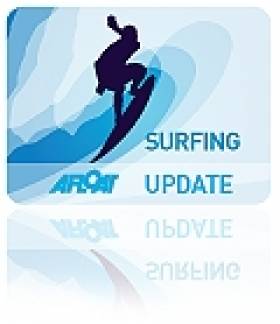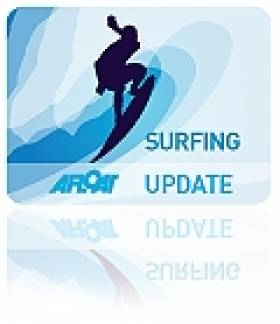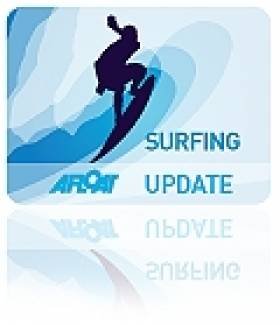Displaying items by tag: Billabong TowIn Session
Surfing Ireland's 'Emerald Slabs' Caught On Video
#Surfing - Check out this stunning video of Portuguese surf pro Nic Von Rupp who cancelled his winter trip to Hawaii last week to take on what Surfer magazine calls 'Ireland's Emerald Slabs'.
Towing out to the storm-fuelled swells of Mullaghmore, Von Rupp shows just how it's done as the world's big wave surfing elite flocked to Sligo for the Billabong Tow-In Session.
Big Waves Come to Mullaghmore After Long Wait
#Surfing - Some of the world's top big wave surfing talent enjoyed the 'day that almost never was' at Mullaghmore in Sligo on Sunday.
As the video above shows, competitors in the long-delayed Billabong Tow-In Session finally got a chance to prove their mettle after two amber alerts in a week for the international event, pushed back from last year after a calm storm season.
Confidence was high as the storm front that has been battering Ireland for the past two days made its way across the Atlantic, bringing with it the giant swells needed to green-light the action.
Big wave surfers being secretive sorts, due to the dangerous nature of offshore tow-in surfing and their determination to keep their favourite spots 'just for them', we don't yet have results of the action, or even confirmation that the waves were big enough to count!
But what we do know is that the likes of Billabong XXL 2013 Ride of the Year nominee Peter Conroy were present and ready to tackle the colossal walls of water Mother Nature was set to provide.
Meanwhile, Met Eireann warns that gale force winds are expected to continue today (29 January) with southwesterly gusts of up to 110 km/h possible. Those in coastal areas have been warned to exercise caution.
Surfers On Amber Alert for Third Annual Tow-In Session
#Surfing - Some of the world’s best big wave surfers were last week hurriedly making their way to Ireland to compete in the third annual Billabong Tow-In Session at Mullaghmore in Co Sligo.
Event organisers gave the amber light for the one-day event on the strength of a giant swell that was forecast to reach Mullaghmore this past Monday.
As previously reported on Afloat.ie, the waiting period for the event commenced in November 2012 and finishes on 1 March this year. Organisers only need one day of giant waves to stage the event.
The huge North Atlantic swell headed Ireland’s way looked like providing surf big enough to stage the event but, most importantly, the forecast giant waves were expected to be accompanied by light and favourable winds.
Last year’s event was cancelled because waves in excess of 20 feet in height, with favourable winds, didn’t arrive during the four-month waiting period. But contest director Paul O’Kane said on the current forecasting models it looked like there would be clean and perfect 20-foot waves at Mullaghmore on Monday.
“For a big wave surfing contest such as this that’s about the minimum size we need to run the event,” he said. “But because the ocean conditions will be so clean and perfect on Monday that’s why we have decided to go to amber alert... This will give all the Irish competitors and those coming from overseas enough time to get here and be well organised with their equipment.
For safety reasons the event is restricted to invitees only. Because lives are at stake, only those surfers with recognised big wave experience have been invited to compete. Competitors are also expected to be well versed and qualified in the all necessary rescue and water safety procedures.
Mullaghmore, along with Aileen’s at the Cliffs of Moher in Co Clare, is fast gaining a reputation as one of the most fearsome and challenging big wave locations in the world.
Irish surfers competing in the event are Richie Fitzgerald and Peter Craig (Donegal), Dave Lavelle and Mikee Hamilton (Sligo), Peter Conroy and Ollie O’Flaherty (Clare), Hugh Galloway (Galway) and Al Mennie (Antrim). The international field this year also includes competitors from Ireland, Hawaii, USA, Great Britain, France, Spain, Germany, Tahiti and South Africa.
The event is sanctioned by the Irish Surf Rescue Club and the Irish Surfing Association. Here's hoping we learn soon if the day was a roaring success or a wipeout!
Surfers On Standby for Third Big Wave Tow-in Session
#SURFING - Some of the world's best big wave surfing stars are making their way to Ireland again this winter to compete in the third annual Billabong Tow-In Session.
The waiting period for the event started on November 1 and finishes on March 1. Organisers only need one day of giant waves at Mullaghmore in Co Sligo to stage the event.
And as reported yesterday on Afloat.ie, this weekend could produce some big results as growing swells in the Atlantic combine with southerly winds.
Last year's event was cancelled because the required waves in excess of 20 feet failed to arrive during the four-month waiting period.
The inaugural event in 2010, however, saw competitors taking on 20-30 foot waves at Mullaghmore, a break that is fast gaining a reputation as one of the most fearsome and best big wave locations in the world.
"Mullaghmore is an incredible wave, one of the heaviest I've surfed and one that holds unlimited potential for giant waves," said the 2010 winner Benjamin Sanchis from France.
Sanchis and his partner Eric Rebiere have been invited back to defend their title.
Along with the defending champions competitors from Ireland, Hawaii, USA, Great Britain, France, Spain, Germany, Tahiti and South Africa have all been invited.
The runner-up pair from the inaugural event, Peter Conroy (Co Clare) and Glyn Ovens (UK), are among several Irish teams set to challenge the overseas surfers in their home country.
"Mullaghmore is impressive with its grassy headland acting as natural amphitheatre for spectators to watch the event," said Conroy, "but it's a scary place when the surf is big. There's lots water swirling around and surging up from the underwater reef ledges.
"Hopefully this year's event will get great waves and we will all return safely to shore."
Because lives are at stake, only those surfers with recognised big wave experience are invited to compete. Competitors are also expected to be well versed and qualified in all the necessary rescue and water safety procedures.
The event is sanctioned by the Irish Surf Rescue Club and the Irish Surfing Association.


























